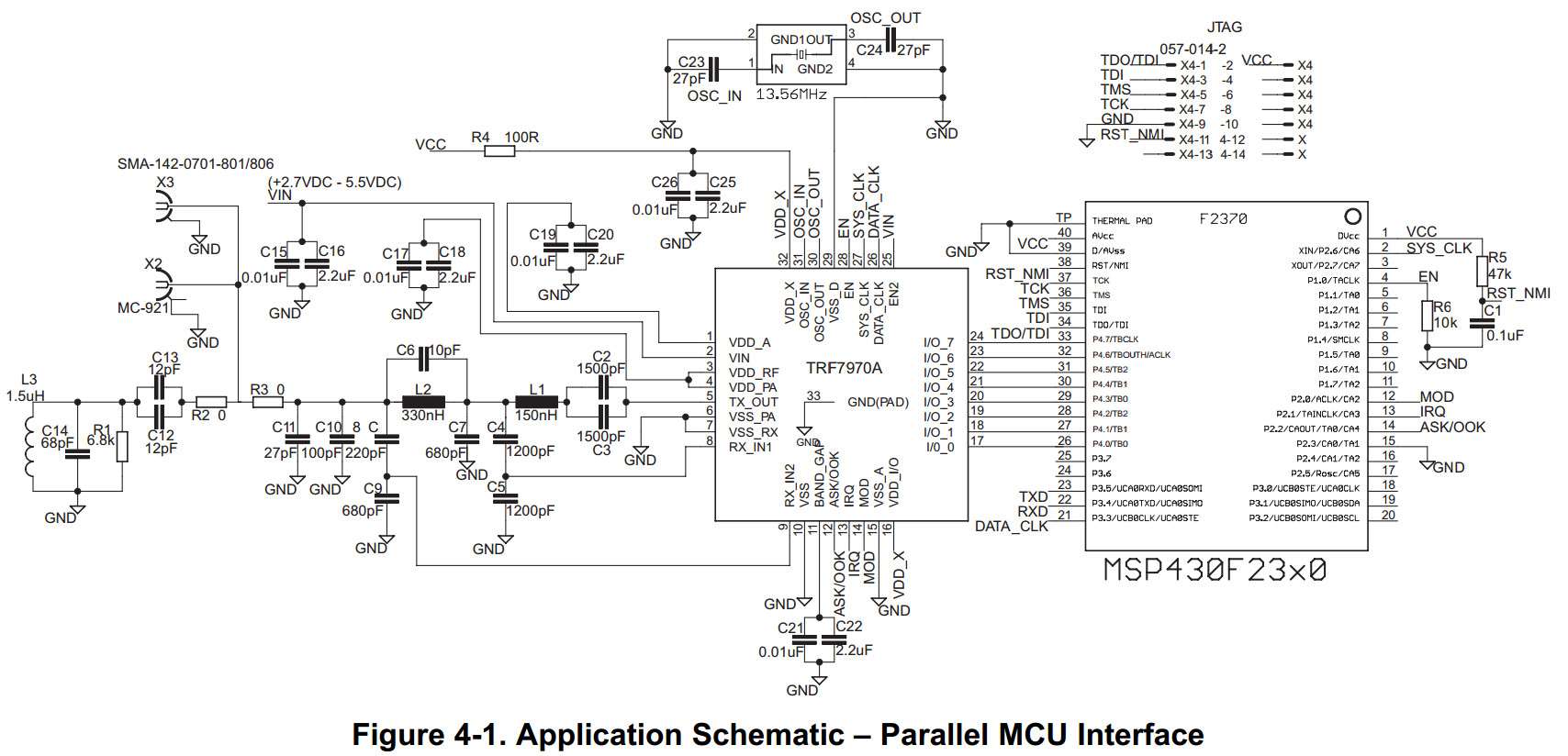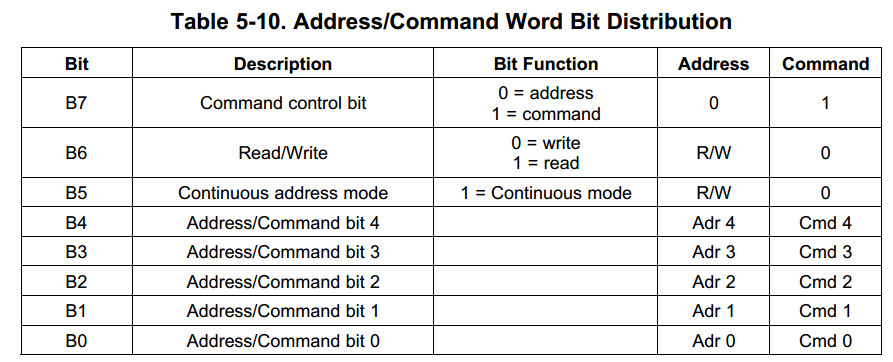TRF7970A IC Communication Interface




General Introduction
The communication interface to the reader can be configured in two ways:
with a eight line parallel interface (D0:D7) plus DATA_CLK, or
with a three or four wire Serial Peripheral Interface (SPI).
The SPI interface uses traditional Master Out/Slave In (MOSI), Master In/Slave Out (MISO), IRQ, and DATA_CLK lines.
The SPI can be operated with or without using the Slave Select line.
These communication modes are mutually exclusive; that is, only one mode can be used at a time in the application.
When the SPI interface is selected, the unused I/O_2, I/O_1, and I/O_0 pins must be hard-wired as shown in Table 5-9.
At power up, the TRF7970A samples the status of these three pins and then enters one of the possible SPI modes.
The TRF7970A always behaves as the slave device, and the microcontroller (MCU) behaves as the master device.
The MCU initiates all communications with the TRF7970A, and the TRF7970A makes use of the Interrupt Request (IRQ) pin
in both parallel and SPI modes to prompt the MCU for servicing attention.
Communication is initialized by a start condition, which is expected to be followed by an Address/Command word (Adr/Cmd).
The Adr/Cmd word is 8 bits long, and its format is shown in Table 5-10.
The MSB (bit 7) determines if the word is to be used as a command or as an address.
The last two columns of Table 5-10 show the function of the separate bits if either address or command is written.
Data is expected once the address word is sent.
In continuous-address mode (Cont. mode = 1), the first data that follows the address is written (or read) to (from) the given address.
For each additional data, the address is incremented by one.
Continuous mode can be used to write to a block of control registers in a single stream without changing the address;
for example, setup of the predefined standard control registers from the MCU non-volatile memory to the reader.
In non-continuous address mode (simple addressed mode), only one data word is expected after the address.
Address Mode is used to write or read the configuration registers or the FIFO. When writing more than 12 bytes to the FIFO,
the Continuous Address Mode should be set to 1.
The Command Mode is used to enter a command resulting in reader action
(for example, initialize transmission, enable reader, and turn reader on or off).
Examples of expected communications between an MCU and the TRF7970A are shown in the following sections.
The IRQ line is indeed the interrupt back to the MCU to indicate something has occurred. The reading of the IRQ status register is then the pointer to the logic of what to do next. For example, after transmitting out a command sequence to a tag, you will get an IRQ which needs to be serviced by reading the IRQ status register (which clears the IRQ), then most likely you would have an 0x80, telling you that the transmission was successful (we call EOTX (end of transmit) IRQ)...then you would next get an IRQ, which would for example be 0x40, indicating an EORX (end of recieve) has occured, then you would read the FIFO status for # of bytes to clock out, then read the FIFO for the data...you can see in the data sheet the descriptions of the IRQ register and and some examples, too. (see the TRF7970A DS, section 5.9.xx)
The ASK/OOK line in your case most likely can just be pulled to GND or you can connect it to a GPIO on your MCU like we have it shown in the reference schematics. MOD same thing, unless you are using any Mifare Classic tags, then you would need control of the MOD pin for Direct Mode 0, so then it would need to be connected to a GPIO.
Usually we are recommending connecting EN line to a GPIO, with a pulldown (needs to see low to high transition) so you can have control of some of the power modes...EN2 can also be connected to a GPIO or pulled high or low, depending on your need for even lower power consumption.
Correct about I/O_0, I/O_1 and I/O_2 being at GND potential for SPI w/o SS.
If it helps here is a schematic of SPI with SS, which you can modify for your own usage, since you say you want to do without SS. (I/O_3 and I/O_5 are connected in this drawing as well, and this is for Special Direct Mode, which you may or may not need, depending on which tags you are trying to use here - normally not needed, just FYI)
7183.TRF7970A_SPI_MSP430F2370_dongle_sch.pdf

TRF7970A IC Communication Interface的更多相关文章
- USB组合设备 Interface Association Descriptor (IAD)
Communication Device Class,简称CDCUSB Compound Device,USB复合设备USB Composite Device,USB组合设备 摘要USB复合设备 Co ...
- (转)什么是CDC类(Communication Device Class)
全文地址:http://justmei.blog.163.com/blog/static/1160998532010321112522467/ 什么是CDC类 (Communication Devic ...
- Chrysler -- CCD (Chrysler Collision Detection) Data Bus
http://articles.mopar1973man.com/general-cummins/34-engine-system/81-ccd-data-bus CCD (Chrysler Coll ...
- 实验室项目.md
1 嵌入式操作系统 为什么要用嵌入式操作系统 普通的单片机编程:程序(软件)--单片机硬件: 嵌入式操作系统开发:程序(软件)--操作系统--嵌入式硬件(包括单片机等); 我们平时普通所学的单片机编程 ...
- Linux内核配置选项
http://blog.csdn.net/wdsfup/article/details/52302142 http://www.manew.com/blog-166674-12962.html Gen ...
- Smart internet of things services
A method and apparatus enable Internet of Things (IoT) services based on a SMART IoT architecture by ...
- Indexing Sensor Data
In particular embodiments, a method includes, from an indexer in a sensor network, accessing a set o ...
- 深入linux kernel内核配置选项
============================================================================== 深入linux kernel内核配置选项 ...
- Fedora 24中的日志管理
Introduction Log files are files that contain messages about the system, including the kernel, servi ...
随机推荐
- supervisor 的使用
1.通过yum安装 supervisor: 2.supervisorctl 查看状态: 3.supervisor.d 下查看配置文件,修改命令和日志目录 4.tail -f /var/log/supe ...
- charles抓包误点deny处理办法及日常抓包
误点deny方法在最底下~~ (博文为转载) 我们在开发网站项目的时候,我们可以通过浏览器的debug模式来看request以及response的数据,那么如果我们开发移动端项目没有网页呢?如何抓取数 ...
- acm专题---最小生成树
kruscal(eloge): 题目来源:http://acm.hdu.edu.cn/showproblem.php?pid=1102 Problem Description There are N ...
- ImageNet Classification with Deep Convolutional Neural Network(转)
这篇论文主要讲了CNN的很多技巧,参考这位博主的笔记:http://blog.csdn.net/whiteinblue/article/details/43202399 https://blog.ac ...
- [Vuejs+php] MySQL数据转JSON传值到前端
说在前面 JSON(JavaScript Object Notation) 是一种轻量级的数据交换格式. 优点如下[转]: 1.占带宽小(格式是压缩的) 2. js通过eval()进行Json读取(便 ...
- WinPhone8 开发(一)[SDK安装+新建项目]
微软 WinPhone8 开发 winphone8 SDK下载地址,见博客:http://blog.csdn.net/attagain/article/details/8509511 SDK安装界面: ...
- loadrunner脚本编写http协议
- Ngnix的日志管理和用定时任务完成日志切割
一.日志管理 先来看看ngnix的配置文件的server段 接下来我们解释一下默认格式的具体意思 #log_format main '$remote_addr(远程IP) - $remote_user ...
- BNUOJ 52509 Borrow Classroom
最近公共祖先. 如果$A$到$1$的时间小于$B$到$C$再到$1$的时间,那么一定可以拦截. 如果上述时间相等,需要在到达$1$之前,两者相遇才可以拦截. #include<bits/stdc ...
- Django+Nginx+uwsgi搭建自己的博客(二)
在上一篇博客中,为大家介绍了Django的一些基本概念以及建立了第一个App——Users,并且在数据库中建立了对应的表. 在这篇博客中,将为大家继续介绍数据库模型的定义和相关操作,以及Users A ...
